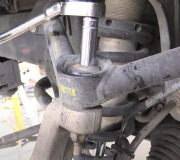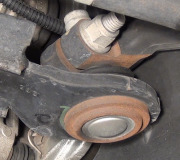Yup, an engine in the trunk will cause the rear springs to sag. That's way more weight than they normally have to hold up. Ford had a huge problem in the '80s with their Escorts. They found that the cars were being tied down too tightly on the car haulers. Of course those cars were a nightmare for owners anyway just because of the idiotic, non-adjustable, way screwed up alignment angles.
Sagging rear suspension shouldn't have that much affect on the front. It will increase caster a little which will give you slightly more road feel, slightly harder steering, and slightly more directional stability. The key word is "slightly". I don't think you will notice the change unless you're really looking for it.
When you have excessive wear on the outer edge of just one front tire, it is due to excessive positive camber. That means the top of the tire is leaning out too much as viewed from the front or rear of the car. Tires tend to pull in the direction they're leaning so you probably have a pull to the right. To counteract that, your steering wheel will be turned to the left a little, but there's another factor involved that might help determine what is happening.
I can't remember exactly how your steering system is set up so I'll just use the most common style. That would be typical of a Dodge Caravan or Ford Windstar. The steering linkage is behind the steering knuckle / half shaft, and if you look straight back from the lower ball joint, you will see the ball and socket of the outer tie rod end is physically higher than the ball joint, (further from the ground).
When camber is increased on your right wheel, that moves the top of the knuckle outward too. The lower ball joint stays put, but the steering arm on the knuckle, being higher than the ball joint, moves out too. You would have to physically readjust the tie rod end longer to match the new position of the arm. Since it's not really practical to do that while driving, the steering linkage in effect is too short causing that tire to turn to the right. Again, besides counteracting the pull, you will have to steer to the left to bring both tires equal going down the road. That means both will be toed out, or steering toward the sides of the road. Excessive toe out creates an unstable condition where the car follows the tire with the most weight on it, usually the right one due to roads leaning to the right for rain to run off, (road crown), but bumps can momentarily put more weight on the left tire. Additionally, incorrect toe causes wear to both tires equally, if everything else is equal side-to-side. The leading edges of the tires will scrub off. Exaggerate it for clarity if that helps. As toe out increases more and more, pretty soon the tire is sideways pointing 90 degrees to the side. Now it's easy to see the leading edge is the inside of the tire. Watch what happens to a pencil eraser if you hold the pencil straight up and drag the eraser along the table top. The leading edge scrubs off and makes eraser crumbs, but the trailing edge lifts up off the table. No wear takes place on the trailing edge. That's what happens with toe wear. It will always occur to both tires on the same axle equally because even if only one wheel is misadjusted, to prevent the car from going that way, you have to turn the steering wheel until both tires are tugging equally against each other. For tires to wear, total toe, (both tires together), must be incorrect.
You can really see this phenomenon on GM front-wheel-drive cars with the center take-off rack and pinion steering system. The outer tie rod ends are up real high. Any tiny change in camber causes a real big change in toe for that wheel. Some cars, in particular GM and Chrysler products from the '70s, had the outer tie rod exactly the same height as the lower ball joint. Changes in camber on those had no effect on toe or steering wheel position. That doesn't mean much to you but it was sure nice for the alignment technician.
The opposite happens on cars with the steering linkage in front of the spindles / half shafts. On those vehicles, when camber increases and the tire tips out on top, the tie rod causes the wheel to turn in toward the center of the car. If that happened to the left tire, that would cause the car to pull left from camber, and steer right from toe. Where the steering wheel ends up is anyone's guess, and it's not fun to drive.
Another issue with ride height on the front has to do with alignment angles. The lower control arm, (and the upper ones on vehicles that use them), go through an arc as the suspension goes up and down. You can really see this on the Ford Bronco 2 or Ranger with twin I-beam suspension. That's a strong suspension system but that's the only good thing that can be said about it. As you bounce those vehicles, you will see the front tires tip in and out on top. That's what happens as the vehicle bounces going down the road. On normal cars and trucks with control arms, the arc they make is very small. Hold your arm straight out to your side, then move it up and down six inches. How much closer do your fingers get to your body? The distance change is only a few sixteenths of an inch. Now lower your arm halfway down and do the same thing. As you raise and lower your arm, the distance of your fingertips from your body changes a few inches. That's what happens when the ride height of the suspension system is not within its design limits. This causes the lower ball joint to move left and right as the vehicle bounces up and down. Upper ball joints, when used, move even more because the arms are always shorter than the lower arms. This causes the tire to slide left and right as the suspension goes through its travel, and it tips in and out excessively. This is why we say when ride height is not correct, you can align to the hoist, not to the road. That means we can set each wheel to factory specs when the vehicle is standing still, but they won't go through the normal motions as you're bouncing down the road. That's why you can have excessive tire wear even when the alignment numbers are perfect. The wear comes from the tire tipping in and out and from scrubbing sideways. That scrubbing was actually a problem a long time ago when the upper and lower control arms were the same length. The wear was minimized by going to the "SLA" suspension system, (short / long arm). That's why the upper control arm is shorter than the lower one.
Your alignment should not be changing very much due to sagging springs over just two months. That is more of a few year thing. Fast cornering should also not be a factor unless you hit a curb, ... After sliding sideways, ... After bouncing through a pothole, ... After wiping out a raccoon, ... That was in a tree! I wish I could remember how the adjustments are made on your truck but there may not even be an adjustment for camber. Some vehicles require the upper strut mounts to be lowered and rotated to one of four positions to set camber and caster each to one of two settings. Those vehicles are not going to see camber change unless there are worn parts. That would mean inspecting ball joints, control arm bushings, struts, and their upper mounts.
On some vehicles, the front cross member can be loosened and shifted sideways to make the two camber values equal. That works on vehicles that have the lower control arms mounted to that cross member. That can be done on the rear of many cars that don't have rear camber adjustments.
Based on your description of tire wear, I would be inclined to think a camber adjustment has slipped. It wouldn't have to have been a raccoon; a turtle could do that too. Also feel along the bottom of the coil springs where they sit on the plate welded to the strut body. Often the lower-most coil or half coil will break off due to rust causing a change in height. Move your fingers slowly because a broken coil usually leaves a sharp edge. For vehicles with torsion bar springs, they rarely break but it is common for them to sag at much lower mileages than coil springs. They always have a means of adjustment so they do not need to be replaced. The year and mileage of your vehicle suggest otherwise, but those springs should be included in an inspection.
Caradiodoc
Wednesday, October 27th, 2010 AT 4:08 PM


